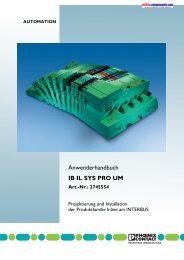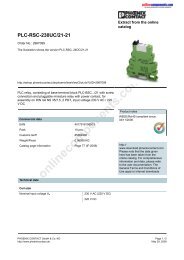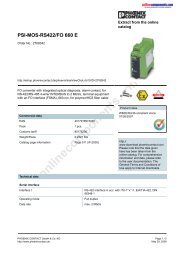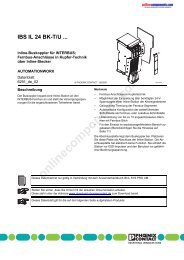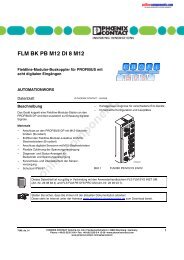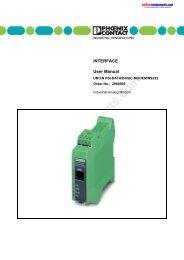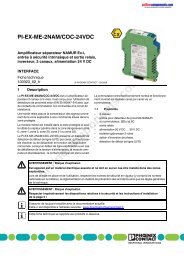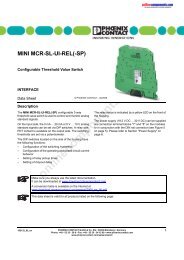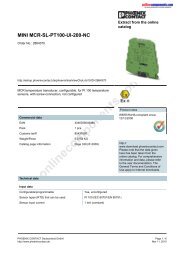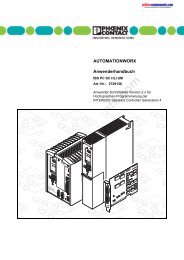UM EN FLX ASI SYS PRO INST - Onlinecomponents.com
UM EN FLX ASI SYS PRO INST - Onlinecomponents.com
UM EN FLX ASI SYS PRO INST - Onlinecomponents.com
Create successful ePaper yourself
Turn your PDF publications into a flip-book with our unique Google optimized e-Paper software.
<strong>UM</strong> <strong>EN</strong> <strong>FLX</strong> <strong>ASI</strong> <strong>SYS</strong> <strong>PRO</strong> <strong>INST</strong><br />
1.4.1 Easy Handling<br />
In the AS-Interface system, the binary I/O device is addressed via the control system (PLC)<br />
in the same way as when using I/O boards and a cable harness. The direct addressing of<br />
devices and the simple electromechanical structure (penetration technique, tree structure)<br />
also simplify retrofitting and the conversion of an AS-i system.<br />
No special knowledge of the system, e.g., for service and maintenance, is required in order<br />
to ensure a smooth transition from the previous star cabling to serial bus technology. The<br />
unerring self-diagnostics of the AS-i system significantly contribute to the reduction of<br />
system downtimes. For example, when replacing a faulty slave device it is not necessary to<br />
assign a new address or modify the PLC program. The AS-Interface system supports the<br />
replacement of a slave through automatic addressing.<br />
1.4.2 Information Content of Data Telegrams<br />
The AS-Interface system is optimized for networking the most basic devices using just a few<br />
items of bit information per device. The data telegrams are therefore very short and have a<br />
very simple structure. This means that the electronics to be integrated in the devices can be<br />
created cost-effectively. The AS-i telegram contains a maximum of four data bits for<br />
information exchange from the control system to the slave (output data) and from the slave<br />
to the control system (input data). Both the input data and the output data are updated in<br />
each cycle.<br />
For more <strong>com</strong>plex devices, e.g., analog devices, larger amounts of data can also be<br />
transmitted. This data must be split and transmitted in several consecutive cycles in<br />
multiplex mode.<br />
1.4.3 Communication Principle<br />
The AS-Interface system is a single master system. A bus access method is used for<br />
<strong>com</strong>munication, which ensures a defined and fast response time. Communication is always<br />
initiated by the master, the slaves only respond to master requests. The master<br />
<strong>com</strong>municates cyclically with all devices, which are addressed using an address that is<br />
programmed once. A master cycle consists of the requests for all connected devices. This<br />
<strong>com</strong>munication method is known as cyclic polling.<br />
1.4.4 Time Response<br />
online<strong>com</strong>ponents.<strong>com</strong><br />
The cycle time of the AS-Interface system is deterministic and proportional to the number of<br />
devices. A time of 150 microseconds is required per device. At full system configuration with<br />
62 devices, the cycle time is 10 milliseconds. At the end of this time, all information that was<br />
transferred from the control system to the Fieldline Extension AS-Interface system (the<br />
master) has arrived at the slaves. Within this time all input data has also been read.<br />
1-4 PHO<strong>EN</strong>IX CONTACT 7513_en_01



